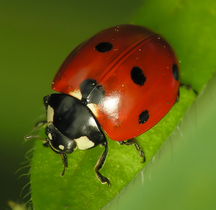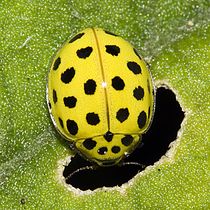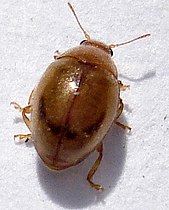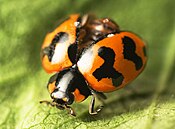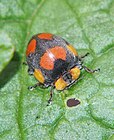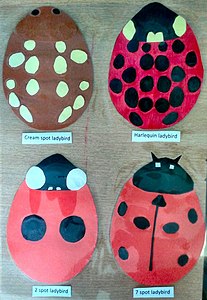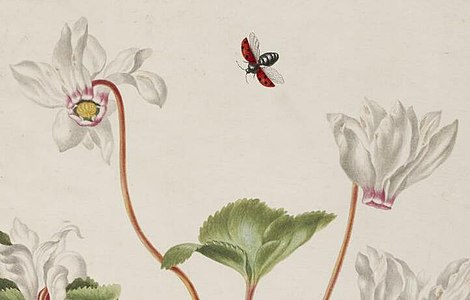Coccinellidae
| Ladybird, ladybug, lady beetle Temporal range:
| |
|---|---|

| |
| Coccinella septempunctata | |
| Scientific classification | |
| Domain: | Eukaryota |
| Kingdom: | Animalia |
| Phylum: | Arthropoda |
| Class: | Insecta |
| Order: | Coleoptera |
| Suborder: | Polyphaga |
| Infraorder: | Cucujiformia |
| Superfamily: | Coccinelloidea |
| Family: | Coccinellidae Latreille, 1807[1] |
| Subfamilies[1] | |
|
(traditional, but see below):
| |
| Synonyms | |
| |
Coccinellidae (
Most coccinellid species are
Species that prey on agricultural pests are considered
Etymology
The name Coccinellidae, created by
Description
Coccinellids range in size from 0.8 to 18 mm (0.03–0.7 in).
As adults, these beetles differ from their closest relatives with the following morphological characteristics:[18]
- Five pairs of spiracles (holes) on the abdomen
- A tentorium (internal supports inside the head) with separated branches at the front and no bridge
- No line dividing the frons and clypeus (frontoclypeal suture)
- Maxillary palps with non-needle-shaped tips,
- Divided galea and lacinia (lobes at the end of the mouthparts)
- Smaller molar (flattened) area of the mandible
- Coxal cavities (holes where the leg articulates with the thorax) that open from the back in the front of the thorax and from the front in the middle of the thorax
- Epimeron (corner plates) on the metathorax with parallel edges
- Lines on the second abdominal sternum
- Tube-shaped, siphon-like genitalia in the male
Coccinellids are often distinctively coloured and patterned. The elytron may be light with dark spots or dark with light spots. Light areas are typically yellow, red, orange or brown, and the spots vary in size and shape and numbers. Some species have striped or
Coccinellid
- Appearance of different species
-
Coccinella septempunctata, black spots on red
-
Psyllobora vigintiduopunctata, black spots on yellow
-
Vibidia duodecimguttata, whitish spots on brown
-
Brumoides suturalis, longitudinally striped
-
Rhyzobius chrysomeloides, brown, unspotted
Evolution
Fossil history
Over 6,000 living species of Coccinellidae have been described.
Phylogeny
The Coccinellidae are within the superfamily Coccinelloidea, which in turn is part of the infraorder Cucujiformia, a group containing most of the plant-eating beetles. The ladybirds form the majority of the species in the Coccinelloidea; many of the rest are fungus-feeding beetles or scavengers.[27]
| Cucujiformia |
| |||||||||||||||||||||||||||||||||||||||||||||||||||||||||||||||||||||||||||
Coccinellidae have historically been divided into up seven subfamilies (Chilocorinae, Coccidulinae, Coccinellinae, Epilachninae, Microweiseinae, Scymninae and Sticholotidinae) and 35 tribes based on morphology. However, genetics studies have called into question the monophyly (single ancestry) of most of these subfamilies. The monophyly of Coccinellinae has the most support.[28][29]
A 2021 genetic study sampling many species, identified three subfamilies, Microweiseinae (with three tribes), Coccinellinae (26 tribes) and a newly identified group, the
| Coccinellidae |
| ||||||||||||||||||||||||
An earlier 2009 study concluded that consumption of
Biology and ecology
Flight
Coccinellids mostly fly during the day.[31] Springy, cylindrical veins in the hindwings stiffen when in flight and bend when folding. Folding of the wings is further aided by creases in the membrane.[32] These beetles may migrate long distances to hibernation and breeding sites, and areas with more food. They appear to be drawn to recognisable landmarks.[33] The more crowded an area is, the more individuals leave, but will remain if there are enough prey species to feed on.[34] "Trivial flights" refer to flying while foraging or when finding a place to lay eggs.[33] One study of species in Britain found that coccinellids can fly as far as 120 km (75 mi). They flew at speeds of 30 km/h (19 mph) and could reach altitudes close to 1,100 m (3,600 ft).[35]
- Behaviour
-
Coccinella transversalis, elytra in the open position
-
Full wings of a Harmonia axyridis taking flight
Life cycle
In temperate climates, coccinellids typically breed from late spring to early summer. In warmer temperate regions, reproduction may occur in spring, fall and winter; tropical species reproduce during the wet season.[7][36] Mating is promiscuous. In some species, females appear to be selective in their partners, preferring males of a certain size and colour. Males produce sperm packets each with 14,000 sperm, and insert three of them into the female, even though she can only hold 18,000 sperm. This is likely a form of sperm competition.[7][37] Like other insects, coccinellids develop from egg, to larva, to pupa and finally adult. Eggs tend to be bright yellow, and the females lay them close together, standing upright and near where they can access food.[7] The number of eggs in a cluster can vary depending on the species; it is typically in the double digits but some species can lay over a thousand eggs in their lifetime.[38]
After hatching, the larvae will begin eating, including the other eggs in their clutch.[7] Certain species lay extra infertile trophic eggs with the fertile eggs, providing a backup food source for the larvae when they hatch. The ratio of infertile to fertile eggs increases with scarcity of food at the time of egg laying.[39] Larvae typically have four instar stages with three moults between them.[40] The larva eventually transitions into a pupa; which involves the development of a hunch, the fusion of the legs to the body, and the attachment of the posterior to the surface.[7][18][40]
Pupae may be uncovered, partially covered or fully covered by larval skin depending on the species. The pupa is mostly immobile, but the head can move in response to irritation. When the adult emerges, it has its hindwings, while the elytron starts out softer and lighter in colour, with no patterns.[41] The length of each development stage varies based on climate and between species. For Adalia bipunctata, eggs hatch after four to eight days, the larva stage lasts around three weeks and the pupa lasts seven to ten days.[7] Adult coccinellids develop much of their final colouration within hours, but may not fully darken for weeks or months.[42] The lifespan of an adult reaches up to a year.[7]
In temperate areas, coccinellids may
- Life cycle
-
Adults mating
-
Eggs (match for scale)
Trophic roles
Coccinellids act both as predators, prey and
Ladybird species vary in dietary specificity. An example of a specialist species is those of the genus Stethorus, which feed on spider mites. Aphid-eaters tend to be generalist; they have a high voracity and can multiply quickly in response to outbreaks, and switch to other prey when the ephemeral aphids become scarce. Predators of scale insects tend to be less voracious and are slower breeders and developers; matching their prey.[48] Under pressure from coccinellid predation, aphid species have evolved to become more toxic, forcing coccinellids to develop immunities.[49] Coccinellid predators of aphids need to defend themselves against ants that tend and defend aphids for their honeydew,[50] and coccinellid eggs laid near aphids are disposed of.[44] Some species including Coccinella magnifica and Diomus have adapted to grow within ant nests as larvae, and some like Diomus thoracicus are predators of the brood of the ant Wasmannia auropunctata.[51][52]
Cannibalism has been recorded in several species; which includes larvae eating eggs or other larvae, and adults feeding on individuals of any life stage.[53] Some coccinellids are mostly non-predatory, such as some species in the genera Epilachna and Henosepilachna.[54][55] The majority of predatory species may also supplement their diet with other sources of food both in their larval and adult stages.[56] Non-animal matter consumed include leaves, pollen, nectar, sap, fungi, and honeydew.[45][56][57] Members of the tribe Halyziini of the subfamily Coccinellinae are obligate fungus feeders.[58]
Coccinellids of any lifestage are preyed on by predators such as birds, spiders, ants and
- Diet
-
Henosepilachna guttatopustulata, an herbivore, feeding on a potatoleaf
-
Yellow-shouldered ladybird, Apolinus lividigaster eating an aphid
-
Harmonia axyridis larva cannibalism
Defense

The bright warning colouration of many coccinellids
The similarity of coccinellid patterning in red and orange with black markings has led to suggestions that they and some species of chrysomelids[67] form Müllerian mimicry rings[68] particularly to defend them from birds.[69] Despite their chemical defenses, coccinellids are preyed on by some clerid beetles in the genus Enoclerus, several species of which are brightly coloured in red and black, and which possibly sequester the toxins of the prey to defend themselves against other predators.[70]
As an anti-predator defense, spiders of the genus Eresus, known as ladybird spiders, have evolved to replicate the patterns of coccinellids. This is a form of Batesian mimicry, as the spiders lack the chemicals. This resemblance is limited to adult male spiders which are actively searching for females and exposed – unlike the females and young, which remain sheltered in burrows.[71]
Distribution and status
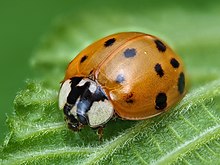
Coccinellidae are found on every continent except Antarctica.
Threats to coccinellids include
As of 2022, the IUCN Red List does not list the conservation status for any coccinellid, though there is an IUCN SSC Ladybird Specialist Group. Conservationists have suggested several measures for protecting the insects, including citizen science and education programs, habitat preservation and restoration, prevention of the spread of invasive species and a global monitoring program.[73]
Relationship to humans
Biological control

Coccinellids have been valued in biological pest control, as they prey on agricultural pests such as aphids and scale insects. Their importance in controlling pests was noted as far back as 1814 in England.[7] Their efficiency can vary: sometimes they have a relatively small effect on aphid populations; at others they cause significant seasonal declines.[76]
Several species have been
There have been many further attempts to use ladybird species against pests, with varying degrees of success.[79][7] Scale insect-eating coccinellids have been more successfully used than aphid predators.[7] Out of 155 deliberate introductions meant to control aphids by the year 2000, only one was deemed to be "substantially successful". This is due to aphid-eating species being fast-breeding, generalist and voracious, and thus difficult to control.[80]
As pests
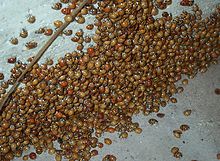
Coccinellids can also act as pests. Harmonia axyridis is native to East Asia, but has been introduced to the Americas, Europe and Africa.
H. axyridis, C. septempunctata and
In culture
Coccinellids have had important roles in culture and religion, being associated with luck, love, fertility and prophecy. "Ladybird" is an affectionate term for someone, such as a loved one. In European folklore, an insect acts as a matchmaker, crawling on a woman and then flying to their true love. Coccinellids have been said to predict the future, particularly weather conditions and how well the crops will grow.[88][89] Contrary to a popular saying, the age of a lady bug cannot be determined by counting its spots.[90]
In Christianity, coccinellids have been seen as the literal gatekeepers of Heaven. A Swedish name for the insects, Himmelska nycla, means "Keys of Heaven". Jews have referred to the insects as the "Cow of Moses our Teacher". The Cherokee have revered them as the "Great Beloved Woman"; this was used as a title for the highest-ranking woman in the government, who would be painted in the colours and patterns of the insect during ceremonies.[91]
Coccinellids have been popularly featured in poems and
Ladybird, ladybird, fly away home,
Thy house is on fire, thy children all roam,
Except little Nan, who sits on her pan,
Weaving gold laces as fast as she can.
-
Card cutout ladybirds for a children's
nature trail -
Ladybird flying over cyclamen, detail,
by Maria Sibylla Merian, 1690s -
Depiction of the Ladybird! Ladybird! rhyme in Hunter Valley Gardens, Australia
References
- ^ a b "Coccinellidae Latreille, 1807". Integrated Taxonomic Information System. Retrieved 24 July 2012.
- ^ "Wikispecies: Microweiseinae". 2012. Retrieved 9 March 2013.
- ISBN 0-19-861263-X.
coccinellid /,kɒksɪ'nɛlɪd/ noun a beetle of a family (coccinelidae) that includes the ladybirds
- ^ Latreille, Pierre A. (1807). Genera crustaceorum et insectorum secundum ordinem naturalem. Vol. 3. Amand Koenig. pp. 70–75.
- ISBN 978-0199231768.
- ^ Majerus 2016, p. 2.
- ^ ISBN 0-12-586990-8.
- ISBN 978-1-9078-0707-7.
- ^ a b c Frank, J. Howard; Mizell, Russell F. "common name: ladybirds, ladybird beetles, lady beetles, ladybugs (of Florida)". Featured creatures. University of Florida. Retrieved 6 December 2022.
- ISBN 978-0811714129.
- ^ Johnson, Ken (4 June 2020). "Ladybug, Ladybug". extension.illinois.edu. University of Illinois Extension. Retrieved 17 January 2023.
- ^ "Common Names of Insects Database". www.entsoc.org. Entomological Society of America. Retrieved 20 January 2023.
- ^ PMID 21426943.
- ^ Hodek, Honěk & Van Emden 2012, p. 78.
- ^ Majerus 2016, p. 16.
- ^ a b c Majerus 2016, p. 17.
- ^ Hodek & Honěk 1996, p. 20.
- ^ a b c d Hodek, Honěk & Van Emden 2012, p. 3.
- ^ Hodek, Honěk & Van Emden 2012, pp. 19–20.
- ^ Hodek, Honěk & Van Emden 2012, p. 26.
- ^ Majerus 2016, pp. 36–37.
- ^ Majerus 2016, p. 39.
- ^ S2CID 225734543.
- .
- S2CID 90619916.
- .
- S2CID 55206626.
- ^ .
- PMID 19903531.
- S2CID 229693745.
- ^ Hodek & Honěk 1996, p. 82.
- PMID 28507159.
- ^ ISSN 1210-5759.
- .
- PMID 24367512.
- ^ Majerus 2016, p. 177.
- .
- ^ Hodek, Honěk & Van Emden 2012, pp. 58–67.
- S2CID 40491195.
- ^ a b Hodek & Honěk 1996, p. 70.
- ^ Hodek & Honěk 1996, pp. 70–71.
- ^ Hodek & Honěk 1996, p. 71.
- .
- ^ .
- ^ a b Majerus 2016, p. 86.
- ^ Hodek, Honěk & Van Emden 2012, p. 490.
- ^ .
- ^ Hodek, Honěk & Van Emden 2012, pp. 489–493.
- ^ Majerus 2016, pp. 99–100.
- .
- .
- ISSN 0033-2615.
- ^ Majerus 2016, pp. 107–115.
- S2CID 84783346.
- ^ Majerus 2016, p. 119.
- ^ .
- .
- .
- ^ ISSN 2224-4255. Retrieved 31 October 2022.
- ^ Hodek & Honěk 1996, pp. 323–350.
- ^ Hodek & Honěk 1996, pp. 349–350.
- .
- S2CID 12356230.
- PMID 11848782.
- PMID 9811809.
- .
- ISBN 978-94-010-7896-2.
- .
- .
- ISSN 1942-1354.
- .
- ^ Majerus 2016, p. 49.
- ^ S2CID 249544157.
- ^ Majerus 2016, p. 71.
- .
- .
- ISSN 0066-4170.
- ^ Hodek, Honěk & Van Emden 2012, p. 491.
- ^ Hodek, Honěk & Van Emden 2012, pp. 491–492.
- ^ Hodek, Honěk & Van Emden 2012, pp. 492–493.
- ^ Potter, Michael F.; Bessin, Ric; Townsend, Lee. "Asian Lady Beetle Infestation of Structures". University of Kentucky-College of Agriculture Cooperative Extension Service. Retrieved 9 December 2022.
- ^ Easton, Sally (2 February 2012). "Ladybird contamination on the rise". The Drinks Business. Union Press. Retrieved 21 June 2013.
- ^ Anonymous (5 July 2001). "Phew, what a scorcher!". The Northern Echo. Archived from the original on 4 July 2009. Retrieved 8 April 2010.
- ^ Wainwright, Martin (17 May 2006). "The great drought". The Guardian. Retrieved 8 April 2010.
- ^ "Could the ladybird plague of 1976 happen again?". BBC News Online. 5 March 2016. Archived from the original on 16 October 2016. Retrieved 15 December 2016.
- PMID 34299616.
- ^ "Mexican bean beetle - Epilachna varivestis Mulsant". University of Florida Institute of Food and Agricultural Sciences. Retrieved 10 December 2022.
- ^ Majerus 2016, pp. 5–7.
- ^ Barševska, Z.; Barševskis, A. (2016). "A ladybird (Coleoptera: Coccinellidae) motif in croched towel end lace: the first example of cultural entomology in Latvia" (PDF). Acta Biol. Univ. Daugavp. 16 (2): 151–154.
- ^ Myth buster: Can you tell a ladybug's age by its spots? In a word, no
- ^ Majerus 2016, pp. 3–4.
- ^ Majerus 2016, p. 8.
Sources
- Hodek, I.; Honěk, A. (1996). Ecology of Coccinellidae (Series Entomologica, 54). Springer. ISBN 978-0792341772.
- Hodek, I; Honěk, A; Van Emden, H. F., eds. (2012). Ecology and Behaviour of the Ladybird Beetles (Coccinellidae). OCLC 792685088.
- Majerus, M (2016). Roy, H. E.; Brown, P. M. J. (eds.). A Natural History of Ladybird Beetles. Cambridge University Press. ISBN 978-1-107-11607-8.
External links
 Media related to Coccinellidae at Wikimedia Commons
Media related to Coccinellidae at Wikimedia Commons Data related to Coccinellidae at Wikispecies
Data related to Coccinellidae at Wikispecies

